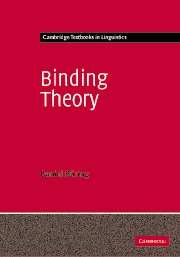Book contents
- Frontmatter
- Contents
- Preface
- 1 The ABC of Binding Theory
- 2 Interpreting indexed structures
- 3 Domains and orientation
- 4 Binding versus coreference
- 5 Other cases of semantic binding
- 6 The Coreference rule
- 7 Descriptive pronouns and individual concepts
- 8 Semantic binding and c-command
- 9 Plurals
- 10 Reciprocals
- 11 Exempt anaphora and reflexivity
- 12 Binding and movement
- Bibliography
- Index
2 - Interpreting indexed structures
Published online by Cambridge University Press: 05 June 2012
- Frontmatter
- Contents
- Preface
- 1 The ABC of Binding Theory
- 2 Interpreting indexed structures
- 3 Domains and orientation
- 4 Binding versus coreference
- 5 Other cases of semantic binding
- 6 The Coreference rule
- 7 Descriptive pronouns and individual concepts
- 8 Semantic binding and c-command
- 9 Plurals
- 10 Reciprocals
- 11 Exempt anaphora and reflexivity
- 12 Binding and movement
- Bibliography
- Index
Summary
In the previous chapter we introduced indexing conventions that expressed our intuitions about the (im)possibility of coreference between two NPs in a given structure. In this chapter I am going to provide a semantic interpretation that cashes out this indexing in semantic terms. It is against this formal, precise interpretation of syntactic indexing that we are going to check the predictions of our theory and its possible modifications later on.
Basics of interpretation
The kind of semantic interpretation we assume here is a truthconditional one. Linguistic expressions are associated with non-linguistic entities, i.e. things in the world (e.g. my left thumb and the Cologne Cathedral), and set-theoretic constructs made out of these (e.g. the set of all my fingers, or the set of all sets that contain that set). The task of the semanticist is to devise basic meanings for the words of the language and systematic ways of combining them so as to arrive at intuitively correct truth conditions for entire sentences.
Since this book is not an introduction to semantics, I will keep the technical apparatus to a minimum. Also, common semantic concepts and techniques will be introduced only very briefly. The formalism introduced and used starting with section 2.3 is for the most part compatible with that laid out in great detail in Heim and Kratzer (1998).
- Type
- Chapter
- Information
- Binding Theory , pp. 25 - 45Publisher: Cambridge University PressPrint publication year: 2005



